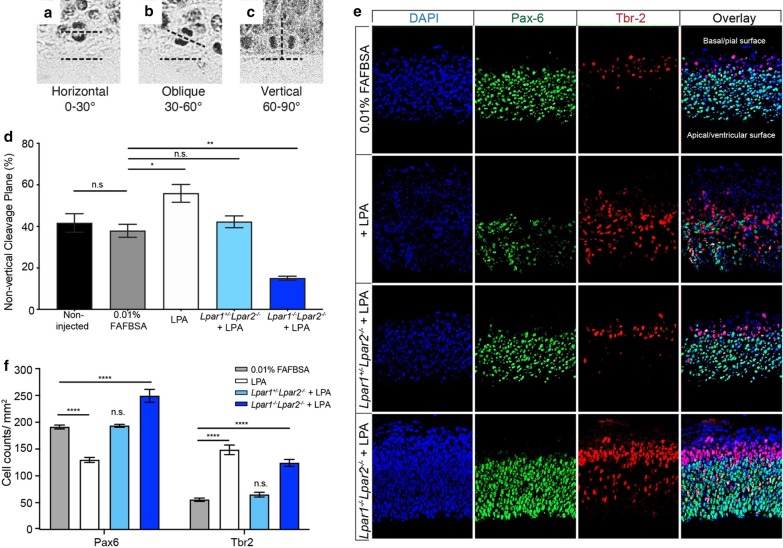Fig. 1.
LPA receptor signaling increases the frequency of non-vertical cleavage planes and alters pro-neurogenic cell fates in vivo. Representative images of apical mitotic progenitor cells at anaphase with a a vertical cleavage plane (60°–90°), b an oblique cleavage plane (30°–60°), and c a horizontal cleavage plane (0°–30°). Cells were classified into these three groups based on the angle of the mitotic cleavage plane relative to the ventricular surface. d Percentage of cells with non-vertical cleavage planes following in vivo injection of LPA (1.4 µM) or vehicle (0.01% BSA) into the lateral ventricles at E13.5. Lpar1 signaling increased the percentage of cells having a non-vertical cleavage plane. Black bar: non-injected (n = 5); gray bar: vehicle (n = 4); white bar: LPA injection (n = 5); light blue bar: LPA injection into Lpar1+/−Lpar2−/− mutant mice (n = 3); and dark blue bar: LPA injection into Lpar1−/−Lpar2−/− mice (n = 3). Methods: brains were fixed 6 h after injection, embedded in paraffin, sectioned at 10 µm and stained with hematoxylin; the cleavage plane angle of anaphase cells was measured throughout the left ventricle in 30 µm increments. Data shown as mean ± SEM. Statistical significance determined by ANOVA with Dunnett’s post-hoc test for multiple comparisons against vehicle-injected controls; n.s. = not significant (P ≥ 0.05), *P = 0.033, **P = 0.0021, ***P = 0.0001). Scale bar 10 µm. e LPA signaling displaces neural progenitor cell population. Representative images comparing LPA effects, relative to vehicle, on progenitor cells (Pax6, green), intermediate progenitor cells (Tbr2, red) and nuclear staining (DAPI, blue) in the cortex of wildtype, Lpar1+/−Lpar2−/−, and Lpar1−/−Lpar2−/− E13.5 mice. Overlaid images (right-most panels) illustrate layer distinctions. f LPA signaling increases the number of Tbr2+ cells. Methods: Total cortical neural progenitor cells (Tbr2 + cells) were counted in 50 μm sagittal sections of E13.5 cortices, 550–950 μm lateral (9 sections analyzed per treatment group). Vehicle-injected wildtype mice (n = 3) were compared with 1.4 μM LPA-injected wildtype (n = 3), Lpar1+/−Lpar2−/− (n = 3), and Lpar1−/−Lpar2−/− (n = 3) mice. Statistical significance determined by ANOVA with Dunnett’s post-hoc test for multiple comparisons against vehicle-injected control. Data shown as mean ± SEM., n.s. = not significant (P ≥ 0.05), *P = 0.033, **P = 0.0021, ***P = 0.0001; unpaired t tests)

